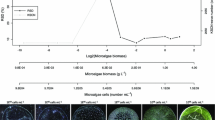Abstract
The present study aims to develop a methodology via Fourier transform infrared (FT-IR) spectroscopy for the semiquantitative determination of triacylglycerols (TAGs) in microalgal consortia, consistent with the use of the technique as process control. FT-IR spectroscopy has proved to be a powerful analytical tool for the identification of macromolecular pools (e.g., proteins, lipids, and carbohydrates) and in monitoring biochemical changes (including lipids) in response to nutrient stress or environmental modifications. In the Oocystis-based consortium under examination, the synthesis of neutral lipid in the form of TAGs can be induced, applying stress condition, and these lipids are suitable as biodiesel precursors. In the exponential growing phase, the consortium shows a low TAGs content, in the order of 5 %w, that can be increased till around 22 %w on ash free dry matter, after nitrogen starvation.









Similar content being viewed by others
References
Bligh EG, Dyer WJ (1959) A rapid method for total lipid extraction and purification. Can J Biochem Physiol 37:911–917
Csavina JL (2008) The optimization of growth rate and lipid content from select algae strains. PhD Thesis, Ohio University, Athens, USA
Dean AP, Sigee DC, Estrada B, Pittman JK (2010) Using FTIR spectroscopy for rapid determination of lipid accumulation in response to nitrogen limitation in freshwater microalgae. Bioresource Technol 101:4499–4507
Eltgroth ML, Robin LW, Gordon VW (2005) Production and cellular localization of neutral long chain lipids in the haptophyte algae Isochrysis galbana and Emiliana huxleyi. J Phycol 41:1000–1009
Griffiths M, Harrison STL (2009) Lipid productivity as a key characteristic for choosing algal species for biodiesel production. J Appl Phycol 21:493–507
Haldane JBS (1930) Enzymes. Longmans, Green
Kiefer E, Sigg L, Schosseler P (1997) Chemical and spectroscopic characterization of algae surfaces. Env Sci Technol 31:759–764
Laurens LML, Wolfrum EJ (2011) Feasibility of spectroscopic characterization of algal lipids: chemometric correlation of NIR and FTIR spectra with exogenous lipids in algal biomass. Bioenerg Res 4:22–35
Marcilla A, Gomez-Siurana A, Gomis C, Chápuli E, Cataláa MC, Valdés FJ (2009) Characterization of microalgal species through TGA/FTIR analysis: application to Nannochloropsis sp. Thermochim Acta 484:41–47
Maxwell K, Johnson GN (2000) Chlorophyll fluorescence—a practical guide. J Exp Bot 51:659–668
Mi-Kyung K, Kyung-Hee J (2009) Use of FT-IR to identify enhanced biomass production and biochemical pool shifts in the marine microalgae, Chlorella ovalis, cultured in media composed of different ratios of deep seawater and fermented animal wastewater. J Microbiol Biotechnol 19:1206–1212
Murdock JN, Wetzel DL (2009) FT-IR microspectroscopy enhances biological and ecological analysis of algae. Appl Spectrosc Rev 44:335–361
Ratledge C (1985) The potential of microorganisms for oil production—a review of recent publications. In. Proceedings of World Conference on Emerging Technologies in The Fats and Oils Industry. American Oil Chemists Society, Cannes, pp. 318–330
Richardson B, Orcutit DM, Martinez CL, Wick HE (1969) Effects of nitrogen limitation on the growth and composition of unicellular algae in continuous culture. Appl Microbiol 18:245–250
Santos JCO, Santos AV, Souza AG, Prasad S, Santos IMG (2002) Thermal stability and kinetic study on thermal decomposition of commercial edible oils by thermogravimetry. J Food Sci 67:1393–1398
Stehfest K, Toepel J, Wilhelm C (2005) The application of micro-FTIR spectroscopy to analyze nutrient stress-related changes in biomass composition of phytoplankton algae. Plant Phys Biochem 43:717–726
Takeuchi T (1992) Carbon dioxide fixation by a unicellular green alga Oocystis sp. J Biotechnol 25:261–367
Acknowledgments
The authors would like to thank their colleagues N. Perin, S. Fanutti for FT-IR analysis, A. Oldani for elementary analysis, M. Vago for HRGC analysis, D. Deriu for TG analysis, and P. Lupo for the realization of the cultivation setup.
Author information
Authors and Affiliations
Corresponding author
Rights and permissions
About this article
Cite this article
Miglio, R., Palmery, S., Salvalaggio, M. et al. Microalgae triacylglycerols content by FT-IR spectroscopy. J Appl Phycol 25, 1621–1631 (2013). https://doi.org/10.1007/s10811-013-0007-6
Received:
Revised:
Accepted:
Published:
Issue Date:
DOI: https://doi.org/10.1007/s10811-013-0007-6




